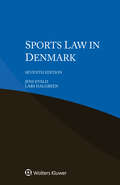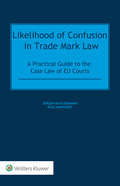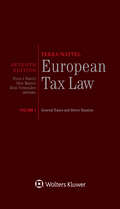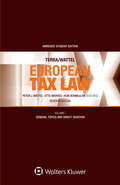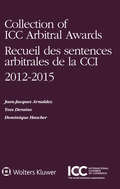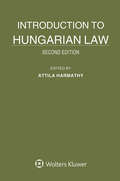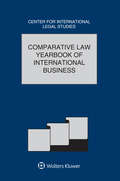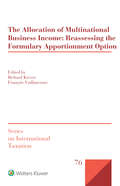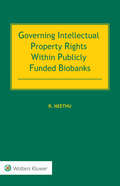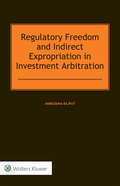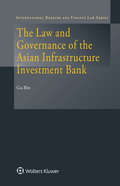- Table View
- List View
Medical Law in the Netherlands
by Herman NysDerived from the renowned multi-volume International Encyclopaedia of Laws, this convenient volume provides comprehensive analysis of the law affecting the physician-patient relationship in the Netherlands. Cutting across the traditional compartments with which lawyers are familiar, medical law is concerned with issues arising from this relationship, and not with the many wider juridical relations involved in the broader field of health care law. After a general introduction, the book systematically describes law related to the medical profession, proceeding from training, licensing, and other aspects of access to the profession, through disciplinary and professional liability and medical ethics considerations and quality assurance, to such aspects of the physician-patient relationship as rights and duties of physicians and patients, consent, privacy, and access to medical records. Also covered are specific issues such as organ transplants, human medical research, abortion, and euthanasia, as well as matters dealing with the physician in relation to other health care providers, health care insurance, and the health care system. Succinct and practical, this book will prove to be of great value to professional organizations of physicians, nurses, hospitals, and relevant government agencies. Lawyers representing parties with interests in the Netherlands will welcome this very useful guide, and academics and researchers will appreciate its comparative value as a contribution to the study of medical law in the international context.
Social Security Law in Finland
by Pentti ArajärviDerived from the renowned multi-volume International Encyclopaedia of Laws, this book describes the social security regime in Finland. It conveys a clear working knowledge of the legal mechanics affecting health care, employment injuries and occupational diseases, incapacity to work, pensions, survivors’ benefits, unemployment benefits and services, and family benefits. The analysis covers the field of application, conditions for entitlement, calculation of benefits, financing, the institutional framework, and relevant law enforcement and controls. Allowances for retirees, employees, public sector workers, the self-employed, and the handicapped are all clearly explained, along with full details of claims, adjudication procedures, and appeals. Succinct yet eminently practical, the book will be a valuable resource for lawyers handling social security matters in Finland. It will be of practical utility to those both in public service and private practice called on to develop and to apply social security law and policy, and of special interest as a contribution to the comparative study of social security systems.
Corporate Acquisitions and Mergers in the United Kingdom
by Nilufer Von BismarckDerived from Kluwer’s multi-volume Corporate Acquisitions and Mergers, the largest and most detailed database of M&A know-how available anywhere in the world, this work by a highly experience partner at the leading international law firm Slaughter and May provides a concise, practical analysis of current law and practice relating to mergers and acquisitions of public and private companies in the United Kingdom. The book offers a clear explanation of each step in the acquisition process from the perspectives of both the purchaser and the seller. Key areas covered include: structuring the transaction; due diligence; contractual protection; considera tion; and the impact of applicable company, competition, tax, intellectual property, environ mental and data protection law on the acquisition process. Corporate Acquisitions and Mergers is an invaluable guide for both legal practitioners and business executives seeking a comprehensive yet practical analysis of mergers and acquisitions in the United Kingdom. Equivalent analyses of M&A law and practice in some 50 other jurisdictions, all contributed by leading law firms, are accessible on-line at www.kluwerlawonline.com. under Corporate Acquisitions and Mergers.
Sports Law in Denmark
by Jens Evald Lars Halgreen<span style="mso-fareast-font-family:"";mso-bidi-font-family:"Times New Roman"; mso-ansi-language:EN-GB">Derived from the renowned multi-volume <span style="mso-fareast-font-family:"";mso-bidi-font-family:"Times New Roman"; mso-ansi-language:EN-GB">International Encyclopaedia of Laws<span style="mso-fareast-font-family:"";mso-bidi-font-family:"Times New Roman"; mso-ansi-language:EN-GB">, this practical analysis of sports law in Denmark deals with the regulation of sports activity by both public authorities and private sports organizations. The growing internationalization of sports inevitably increases the weight of global regulation, yet each country maintains its own distinct regime of sports law and its own national and local sports organizations. Sports law at a national or organizational level thus gains a growing relevance in comparative law. <span style="mso-fareast-font-family:"";mso-bidi-font-family:"Times New Roman"; mso-ansi-language:EN-GB"> <span style="mso-fareast-font-family:"";mso-bidi-font-family:"Times New Roman"; mso-ansi-language:EN-GB">The book describes and discusses both state-created rules and autonomous self-regulation regarding the variety of economic, social, commercial, cultural, and political aspects of sports activities. Self- regulation manifests itself in the form of by-laws, and encompasses organizational provisions, disciplinary rules, and rules of play. However, the trend towards more professionalism in sports and the growing economic, social and cultural relevance of sports have prompted an increasing reliance on legal rules adopted by public authorities. This form of regulation appears in a variety of legal areas, including criminal law, labour law, commercial law, tax law, competition law, and tort law, and may vary following a particular type or sector of sport. It is in this dual and overlapping context that such much-publicized aspects as doping, sponsoring and media, and responsibility for injuries are legally measured. <span style="mso-fareast-font-family:"";mso-bidi-font-family:"Times New Roman"; mso-ansi-language:EN-GB"> <span style="mso-fareast-font-family:"";mso-bidi-font-family:"Times New Roman"; mso-ansi-language:EN-GB">This monograph fills a gap in the legal literature by giving academics, practitioners, sports organizations, and policy makers access to sports law at this specific level. Lawyers representing parties with interests in Denmark will welcome this very useful guide, and academics and researchers will appreciate its value in the study of comparative sports law.
Sports Law in New Zealand
by Elizabeth ToomeyDerived from the renowned multi-volume International Encyclopaedia of Laws, this practical analysis of sports law in New Zealand deals with the regulation of sports activity by both public authorities and private sports organizations. The growing internationalization of sports inevitably increases the weight of global regulation, yet each country maintains its own distinct regime of sports law and its own national and local sports organizations. Sports law at a national or organizational level thus gains a growing relevance in comparative law. The book describes and discusses both state-created rules and autonomous self-regulation regarding the variety of economic, social, commercial, cultural, and political aspects of sports activities. Self- regulation manifests itself in the form of by-laws, and encompasses organizational provisions, disciplinary rules, and rules of play. However, the trend towards more professionalism in sports and the growing economic, social and cultural relevance of sports have prompted an increasing reliance on legal rules adopted by public authorities. This form of regulation appears in a variety of legal areas, including criminal law, labour law, commercial law, tax law, competition law, and tort law, and may vary following a particular type or sector of sport. It is in this dual and overlapping context that such much-publicized aspects as doping, sponsoring and media, and responsibility for injuries are legally measured. This monograph fills a gap in the legal literature by giving academics, practitioners, sports organizations, and policy makers access to sports law at this specific level. Lawyers representing parties with interests in New Zealand will welcome this very useful guide, and academics and researchers will appreciate its value in the study of comparative sports law.
Likelihood of Confusion in Trade Mark Law: A Practical Guide to the Case Law of EU Courts
by Jeroen Muyldermans Paul MaeyaertSince 1994 European Union (EU) case law touching on trade mark confusion has become so diverse and has grown so numerous that it is difficult to see the wood for the trees. This is the first book to give a complete synthesis of the thousands of decisions that have been handed down over the past decades, illustrated with many examples and images. Providing a highly structured and complete overview of the confusion test and all assessment criteria as determined by the General Court and Court of Justice, the authors unravel the concept of likelihood of confusion and establish a sound and thorough methodology for resolving confusion in any trade mark case. Among the practical features offered by the analysis are the following: consideration of the constituent criteria of the confusion test through a simple three-step test examining the similarity among goods and services, similarity between different trade marks and global appreciation of confusion; the identification of the ‘relevant consumer’, including from territorial and linguistic points of view; guidance on procedural aspects of the confusion test before the EU courts, as well as before the EU Intellectual Property Office and its Boards of Appeal; identifying the dominant and distinctive components of a trade mark – phonetic, visual and conceptual; the concept of similarity and the Nice Agreement; the principle of ‘partial use’; effect of the terms of sale of the goods or services; consideration of the existence of a family or series of trade marks; and consideration of the effects of coexistence on the confusion test. Numerous illustrated examples of trade marks involved in confusion cases enhance the presentation. Any practitioner dealing with trademark confusion in infringement proceedings before EU or national courts, or in opposition proceedings before national offices or the EU Intellectual Property Office, will be enabled to approach each case with full awareness of applicable criteria of assessment. This much-needed synthesis of case law will quickly become a standard work among lawyers, examiners and judges acting in trade mark matters.
Genuine Use of Trademarks
by Eléonore GasparThis book addresses the issue of trademark use that may be required for protection and maintenance of trademark rights. While there is considerable harmonization on trademark rights, courts and laws around the world do not always assess in the same way whether a trademark is used and do not always attach the same consequence to lack of use of a trademark. This is a fundamental issue for trademark owners since, depending on the jurisdiction, lack of use can lead to the revocation of trademark rights or to a refusal of trademark registration. This detailed analysis provides clarity, insight and guidance on the legal issues and practical implications of genuine use of trademarks in twenty-six jurisdictions worldwide. This book was developed within the framework of the International Association for the Protection of Intellectual Property (AIPPI), a non-affiliated, non-profit organization dedicated to improving and promoting the protection of intellectual property at both national and international levels. This topic was the subject of an AIPPI study, and subsequent Resolution – "The Requirements of genuine use of trademarks for maintaining protection" (2011, Hyderabad) which aims to harmonize this issue of genuine use of trademarks. The authors of the chapters for each jurisdiction were carefully selected based on their extensive experience and in-depth knowledge of trademark protection in their respective jurisdictions. Each chapter considers issues and topics such as the following: • types of use that qualify as genuine use of a trademark, including requirements as to whether uses are consistent with the function of the trademark or made in the course of trade; • requirements as to the volume, duration and frequency of use; • impact of the trademark's designation of goods and services; • issues relating to the sign used, particularly if it is used in a different form from the registered trademark (this includes consideration of alteration of the distinctive character, or the potential impact of a plurality of registered trademarks for different signs, or the question of use in black and white or in colour); • proof to be provided to evidence genuine use as a trademark, including issues of timing and territory; • situations in which the issue of genuine use can be of importance; • valid reasons for non-use; and • consequences of lack of use depending on the context, including possible revocation of trademark rights. Each chapter includes case law examples. As a comparative law study and a collection of contributions from around the world on a key issue of trademark law, this book is of tremendous practical interest. Trademark owners, parties involved in or contemplating enforcement proceedings, and interested legal practitioners will benefit greatly from its thorough comparative analysis and guidance. It is also exceptionally valuable as a comprehensive resource for academics and researchers interested in the international harmonization of trademark law.
Fidelity Rebates in Competition Law: Application of the 'As Efficient Competitor' Test
by Miroslava MarinovaThis book examines the treatment of fdelity rebates as one of the most controversial topics in EU competition law. The controversy arose from the lack of clarity as to how to distinguish between rebates that constitute a legitimate business practice and those that might have anticompetitive e?ects, as the same type of rebates could be pro-competitive or anticompetitive depending on their e?ects on competition. This book clarifes the appropriate treatment of fdelity rebates under EU competition law by o?ering original insights on the way in which abusive rebates should be identifed, taking into account the wealth of EU case law in this area, the economics' literature and the perspective of US antitrust law. The critical discussion on the case law is centred on the idea as to whether the as efcient competitor (AEC) test is an important part of the assessment of fdelity rebates and in which circumstances it could be used as one tool among others.The analysis treats such issues and topics as the following: – What motivated the EU Courts to treat fdelity rebates as illegal ‘by object'? – Why has this case law drawn so much criticism from academics and other commentators? – What can we learn from the economic theories of exclusive dealing and fdelity rebates, and whether the strict approach of the Courts can be supported by economic empirical studies? – What is the meaning attached to the notion of an ‘e?ects-based' approach as an expression of the reform of Article 102? – Why is the controversy regarding the treatment of fdelity rebates still a live issue after the Intel and the Post Danmark II judgments? – In which circumstances the price-cost test can be used as a reliable tool to distinguish between anticompetitive and pro-competitive fdelity rebates? – Can we evaluate the e?ect of fdelity rebates without necessarily carrying out a price-cost test? – Can we consider the AEC test as a single unifying test for all types of exclusionary abuses? – What can we learn about the application of the AEC test in fdelity rebate cases from the recent US case law? A concluding chapter provides an original perspective and also policy recommendations on how the abusive character of fdelity rebates should be assessed including an appropriate legal test that is administrable, creates predictability and legal certainty and minimises the risk of errors and the cost of those mistakes. This book takes a giant step towards improving the understanding of the legal treatment of fdelity rebates and understanding as to whether the treatment of fdelity rebates could be e?ects-based, without necessarily carrying out an AEC test. It will also contribute signifcantly to the practical work of enforcement agencies, courts and private entities and their advisors. book's parallel study of US and EU competition law.
Corporate Acquisitions and Mergers in India
by Pradeep Kumar Jain<span style="mso-fareast-font-family: ITC-NewBaskervilleA;mso-bidi-font-family:ITC-NewBaskervilleA;color:black">Derived from Kluwer’s multi-volume Corporate Acquisitions and Mergers<span style="mso-fareast-font-family:ITC-NewBaskervilleA;mso-bidi-font-family:ITC-NewBaskervilleA; color:black">, the largest and most detailed database of M&A know-how available anywhere in the world, <span style="color:black; background:#FDFCFB;mso-bidi-font-weight:bold">this work by a highly experienced team from the leading international law firm <span style="mso-bidi-font-size:12.0pt; font-family:ITC-NewBaskervilleItalicA;mso-bidi-font-family:ITC-NewBaskervilleItalicA; mso-ansi-language:EN-US;mso-fareast-language:EN-US;mso-bidi-font-style:italic">Singhania & Co, LLP<span style="font-size:10.0pt;font-family:ITC-NewBaskervilleItalicA;mso-bidi-font-family: ITC-NewBaskervilleItalicA;mso-ansi-language:EN-US;mso-fareast-language:EN-US; mso-bidi-font-style:italic"> <span style="mso-bidi-font-size:12.0pt; mso-ansi-language:EN-US;mso-fareast-language:EN-US;mso-bidi-font-style:italic">Contributors provides a concise, practical analysis of current law and practice relating to mergers and acquisitions of public and private companies in India. The book offers a clear explanation of each step in the acquisition process from the perspectives of both the purchaser and the seller. Key areas covered include: structuring the transaction; due diligence; contractual protection; consideration; and the impact of applicable company, competition, tax, intellectual property, environmental and data protection law on the acquisition process. Corporate Acquisitions and Mergers is an invaluable guide for both legal practitioners and business executives seeking a comprehensive yet practical analysis of mergers and acquisitions in India. Equivalent analyses of M&A law and practice in some 50 other jurisdictions, all contributed by leading law firms, are accessible on-line at www.kluwerlawonline.com under Corporate Acquisitions and Mergers.
Constitutional Law in Spain
by Agustín Ruiz RobledoDerived from the renowned multi-volume International Encyclopaedia of Laws, this very useful analysis of constitutional law in Spain provides essential information on the country's sources of constitutional law, its form of government, and its administrative structure. Lawyers who handle transnational matters will appreciate the clarifications of particular terminology and its application. Throughout the book, the treatment emphasizes the specific points at which constitutional law affects the interpretation of legal rules and procedure. Thorough coverage by a local expert fully describes the political system, the historical background, the role of treaties, legislation, jurisprudence, and administrative regulations. The discussion of the form and structure of government outlines its legal status, the jurisdiction and workings of the central state organs, the subdivisions of the state, its decentralized authorities, and concepts of citizenship. Special issues include the legal position of aliens, foreign relations, taxing and spending powers, emergency laws, the power of the military, and the constitutional relationship between church and state. Details are presented in such a way that readers who are unfamiliar with specific terms and concepts in varying contexts will fully grasp their meaning and significance. Its succinct yet scholarly nature, as well as the practical quality of the information it provides, make this book a valuable time-saving tool for both practising and academic jurists. Lawyers representing parties with interests in Spain will welcome this guide, and academics and researchers will appreciate its value in the study of comparative constitutional law.
Constitutional Law in Argentina
by Antonio María HernándezDerived from the renowned multi-volume International Encyclopaedia of Laws, this very useful analysis of constitutional law in Argentina provides essential information on the country's sources of constitutional law, its form of government, and its administrative structure. Lawyers who handle transnational matters will appreciate the clarifications of particular terminology and its application. Throughout the book, the treatment emphasizes the specific points at which constitutional law affects the interpretation of legal rules and procedure. Thorough coverage by a local expert fully describes the political system, the historical background, the role of treaties, legislation, jurisprudence, and administrative regulations. The discussion of the form and structure of government outlines its legal status, the jurisdiction and workings of the central state organs, the subdivisions of the state, its decentralized authorities, and concepts of citizenship. Special issues include the legal position of aliens, foreign relations, taxing and spending powers, emergency laws, the power of the military, and the constitutional relationship between church and state. Details are presented in such a way that readers who are unfamiliar with specific terms and concepts in varying contexts will fully grasp their meaning and significance. Its succinct yet scholarly nature, as well as the practical quality of the information it provides, make this book a valuable time-saving tool for both practising and academic jurists. Lawyers representing parties with interests in Argentina will welcome this guide, and academics and researchers will appreciate its value in the study of comparative constitutional law.
Terra/Wattel – European Tax Law: Volume I (Full edition)
by Peter J. Wattel, Otto Marres, Hein VermeulenPeter J. Wattel is Advocate General in the Supreme Court of the Netherlands, State Councillor extraordinary in the Netherlands Council of State and professor of EU tax law at the Amsterdam Centre for Tax Law (ACTL), University of Amsterdam. Otto Marres is professor at the ACTL and tax lawyer at Meijburg & Co., Amsterdam. Hein Vermeulen is professor at the ACTL and Director of PwC’s EU Direct Tax Group. The seventh edition of this two-volume set brings a comprehensive and systematic survey of European Tax Law up to January 2018. It provides a state of the art clarification and analysis of the implications of the EU Treaties and secondary EU law for national and bilateral tax law. From the consequences of the EU free movement rights - to the soft law meant to put a halt to harmful tax competition. The seventh edition of European Tax Law offers a cutting-edge analysis of the field surrounding tax law across Europe. It puts forward a thought-provoking discussion of the current EU tax rules, as well as of the EU Court’s case law in tax matters. Previous editions were highly regarded as a staple overview of EU tax law among EU tax law practitioners, policymakers, the judiciary and academics alike. With its updated legislation and case-law up to January 2018, this new edition maintains its unparalleled depth and clarity as the go-to reference book in the field. This first volume of ‘European Tax Law’ extensively covers: 1. The consequences of the EU free movement rights, the EU State aid prohibition, the EU Charter of Fundamental Rights and the general principles of EU law for national tax law, tax treaties, national (tax) procedure, State liability and relations with third States, as they appear from the case law of the Court of justice of the EU 2. Secondary EU law in force and proposed on direct taxes: the Parent-Subsidiary Directive, the Tax Merger Directive, the Interest and Royalties Directive, cross-border tax dispute settlement instruments, the Anti-Tax Avoidance Directive and the C(C)CTB proposal 3. The exchange of information and other administrative assistance in the assessment and recovery of taxes between the EU Member States 4. Soft Law on Harmful Tax Competition 5. Procedural matters and the extent of judicial protection The upcoming second volume of this set will cover harmonization of indirect taxation, energy taxation and capital duty, as well as administrative cooperation in the field of indirect taxation.
Transport Law in Greece
by Kyriaki Noussia Maria GlynouDerived from the renowned multi-volume International Encyclopaedia of Laws, this book provides a systematic approach to transport law as applied in Greece. The book describes the main sources of transport law, jurisdiction and courts, state immunity, and the legal role of transport intermediaries, with detailed reference to maritime law, transport by road, transport by air, transport by rail, and inland navigation. A special chapter is devoted to multimodal transport. Among the elements of transport law considered are the legal status of the vessel; its acquisition, ownership, and registration; vessel liens and mortgages; the position of master and crew; maritime salvage and assistance; marine pollution; collision; and carriage of passengers. Other topics discussed include liability and limitation of liability, charter parties, and transport under bill of lading. Case law, intergovernmental cooperation agreements, and interactions with environmental, tax, and competition law are also covered. Its succinct yet scholarly nature, as well as the practical quality of the information it provides, make this book a valuable resource for lawyers handling transport contracts or cases affecting Greece. It will also be welcomed by researchers and academics for its contribution to a field that continues to gain significance in the study of comparative law.
Terra/Wattel – European Tax Law: Volume I (Student edition)
by Peter J. Wattel, Otto Marres and Hein VermeulenThe seventh edition of this two-volume set brings a comprehensive and systematic survey of European Tax Law up to January 2018. It provides a state of the art clarification and analysis of the implications of the EU Treaties and secondary EU law for national and bilateral tax law. From the consequences of the EU free movement rights - to the soft law meant to put a halt to harmful tax competition. The seventh edition of European Tax Law offers a cutting-edge analysis of the field surrounding tax law across Europe. It puts forward a thought-provoking discussion of the current EU tax rules, as well as of the EU Court’s case law in tax matters. Previous editions were highly regarded as a staple overview of EU tax law among EU tax law practitioners, policymakers, the judiciary and academics alike. With its updated legislation and case-law up to January 2018, this new edition maintains its unparalleled depth and clarity as the go-to reference book in the field. This first volume of the abridged student edition of ‘European Tax Law’ covers: 1. The consequences of the EU free movement rights, the EU State aid prohibition, the EU Charter of Fundamental Rights and the general principles of EU law for national tax law, tax treaties, national (tax) procedure, State liability and relations with third States, as they appear from the case law of the Court of justice of the EU 2. Secondary EU law in force and proposed on direct taxes: the Parent-Subsidiary Directive, the Tax Merger Directive, the Interest and Royalties Directive, cross-border tax dispute settlement instruments, the Anti-Tax Avoidance Directive and the C(C)CTB proposal 3. The exchange of information and other administrative assistance in the assessment and recovery of taxes between the EU Member States 4. Soft Law on Harmful Tax Competition 5. Procedural matters and the extent of judicial protection The upcoming second volume of this set will cover harmonization of indirect taxation, energy taxation and capital duty, as well as administrative cooperation in the field of indirect taxation.
GDPR (EU) 2016/679: Post-Reform Personal Data Protection in the European Union
by Mariusz KrzysztofekPersonal data protection has become one of the central issues in any understanding of the current world system. In this connection, the European Union (EU) has created the most sophisticated regime currently in force with the General Data Protection Regulation (GDPR) of 2016. This book on this major data protection reform offers a comprehensive discussion of all principles of personal data processing, obligations of data controllers and rights of data subjects. This is the core of the personal data protection regime. GDPR is applicable directly in all Member States, providing for a unification of data protection rules within the EU. However, it poses a problem in enabling international trade and data transfers outside the EU between economies which have different data protection models in place. Among the broad spectrum of aspects of the subject covered are the following: – summary of the changes introduced by the GDPR; – new territorial scope; – key principles of personal data processing; – legal bases for the processing of personal data; – marketing, cookies and profiling; – new information clauses; – new Subject Access Requests (SARs), including the ‘right to be forgotten’ on the Internet, the right to data portability and the right to object to profiling; – new data protection by design and by default; – benefits from implementing a data protection certificate; and – data transfers outside the EU, including BCRs, SCCs and special features of EU–US arrangements. This book references many rulings of European courts, as well as interpretations and guidelines formulated by European data protection authorities, examples and best practices, making it of great practical value to lawyers and business leaders. Because of the increase in legal certainty in this area guaranteed by the GDPR, multinational corporations and their customers and contractors will benefit enormously from consulting and using this book. For practitioners and academics, researching or advising clients on this area, and government policy advisors, this book provides an indispensable source of guidance and information for many years to come.
Corporate Acquisitions and Mergers in Singapore
by Andrew M. Lim Lim Mei Richard Young Christopher Ong Daren Shiau Sunit Chhabra Lim Pek Bur Yeo Boon Kiat<span style="mso-fareast-font-family: ITC-NewBaskervilleA;mso-bidi-font-family:ITC-NewBaskervilleA;color:black">Derived from Kluwer’s multi-volume Corporate Acquisitions and Mergers<span style="mso-fareast-font-family:ITC-NewBaskervilleA;mso-bidi-font-family:ITC-NewBaskervilleA; color:black">, the largest and most detailed database of M&A know-how available anywhere in the world, <span style="mso-ansi-language:EN-US; mso-fareast-language:EN-US">this work by highly experienced partners in the leading international law firm <span style="mso-bidi-font-size:12.0pt;font-family:ITC-NewBaskervilleItalicA; mso-bidi-font-family:ITC-NewBaskervilleItalicA;mso-ansi-language:EN-US; mso-fareast-language:EN-US;mso-bidi-font-style:italic">Allen & Gledhill LLP<span style="font-size:10.0pt;font-family:ITC-NewBaskervilleItalicA;mso-bidi-font-family: ITC-NewBaskervilleItalicA"> <span style="mso-fareast-font-family: ITC-NewBaskervilleA;mso-bidi-font-family:ITC-NewBaskervilleA;color:black">provides a concise, practical analysis of current law and practice relating to mergers and acquisitions of public and private companies in <span style="font-size:10.5pt;font-family:"Source Sans Pro",sans-serif; color:#333333;background:white">Singapore. The book offers a clear explanation of each step in the acquisition process from the perspectives of both the purchaser and the seller. Key areas covered include: structuring the transaction; due diligence; contractual protection; consideration; and the impact of applicable company, competition, tax, intellectual property, environmental and data protection law on the acquisition process. Corporate Acquisitions and Mergers is an invaluable guide for both legal practitioners and business executives seeking a comprehensive yet practical analysis of mergers and acquisitions in <span style="font-size:10.5pt;font-family: "Source Sans Pro",sans-serif;color:#333333;background:white">Singapore. Equivalent analyses of M&A law and practice in some 50 other jurisdictions, all contributed by leading law firms, are accessible on-line at www.kluwerlawonline.com under Corporate Acquisitions and Mergers.
Collection of ICC Arbitral Awards 2012 – 2015
by Jean-Jacques Arnaldez Yves Derains Dominique HascherThe Collection of ICC Arbitral Awards 2012-2015 contains extracts of cases handled by the ICC Court of Arbitration, one of the world's most respected arbitral institutions. This most recent collection supplements six previous and successful volumes containing awards from the periods 1974-1985, 1986-1990, 1991-1995, 1996-2000, 2001-2007 and 2008-2011. This collection is a practical reference tool, containing three types of useful indexes incorporating information from all three volumes: – a consolidated analytical table, in both English and French, contains extensive cross-references based on the terminology used in awards and case notes; – a chronological index lists the awards; – a key word index, also provided in both languages, allows the reader to locate the material of interest quickly and easily. In addition to providing a wealth of information in a highly accessible manner, this book includes case notes end expert commentaries on the awards. This publication is an indispensable reference work for anyone interested in international arbitration and in the reasoning of international arbitrators on the interpretation and application of contractual clauses, international conventions, and the law of international trade. It is invaluable to both scholars and practitioners involved in the drafting and negotiation of international commercial contracts and the resolution of international commercial disputes.
Introduction to Hungarian Law
by Attila HarmathyAbout this book: Introduction to Hungarian Law provides a basic knowledge of legal concepts of Hungary, with special emphasis on practical issues. Hungary’s historical connection to the European legal tradition has enabled the country’s legal system to overcome the legal gap caused by political developments after the Second World War. This practical book, far from a simple second edition of the volume published more than ten years ago, details the full-fledged legal system that has been established prior to and since Hungary became a member of the European Union in 2004, and it contains information concerning the existing legal system. This book provides a comprehensive overview of all major areas of Hungarian law, from constitutional law and administrative law to business law and labour law. What’s in this book: Designed for non-Hungarian practitioners encountering Hungarian law in the course of their work, expert local contributors provide, in English, thorough guidance on legal areas, including the following: constitutional law; administrative law; fiscal and financial law; taxation; family law, property law and succession law; contracts; torts; company law; labour law; copyright and patents; private international law; civil litigation; arbitration; and criminal law and procedure. How this will help you: Practising lawyers in every field, business people seeking international markets and academic researchers, government officials and students will find this volume to be of great practical value. It offers a quick and reliable way into any area of Hungarian law that they may be required to research in order to provide straight and simple answers according to the needs of those who may have to interact with the Hungarian legal system.
Comparative Law Yearbook of International Business 40: The Comparative Law Yearbook Of International Business 2010
by Dennis CampbellThis is the fortieth volume of the Comparative Law Yearbook of International Business, and it includes reports by practitioners and experts from Argentina, Australia, Belgium, Germany, India, Italy, The Netherlands, Slovakia, Turkey, and the United States who deal with topics from national and regional perspectives. Authors from Australia and Turkey examine issues relating to investment. Authors from Italy, India, and Slovakia treat matters concerning corporate law. Authors from Germany, Italy, India, and the United States report on topics dealing with litigation and dispute resolution. Authors from Argentina, Belgium, and The Netherlands deal with issues relating to restrictive covenants, commercial law, and trade secrets.
The Allocation of Multinational Business Income: Reassessing the Formulary Apportionment Option
by Richard KreverThe Allocation of Multinational Business Income: Reassessing the Formulary Apportionment Option Edited by Richard Krever & François Vaillancourt Although arm’s length methodology continues to prevail in international taxation policy, it has long been replaced by the formulary apportionment method at the subnational level in a few federal countries. Its use is planned for international profit allocation as an element of the European Union’s CCCTB proposals. In this timely book – a global guide to formulary apportionment, both as it exists in practice and how it might function internationally – a knowledgeable group of contributors from Australia, Canada, the United Kingdom and the United States, address this actively debated topic, both in respect of its technical aspects and its promise as a global response to the avoidance, distortions, and unfairness of current allocation systems. Drawing on a wealth of literature considering formulary apportionment in the international sphere and considering decades of experience with the system in the states and provinces of the United States and Canada, the contributors explicate and examine such pertinent issues as the following: the debate about what factors should be used to allocate profits under a formulary apportionment system and experience in jurisdictions using formulary apportionment; application of formulary apportionment in specific sectors such as digital enterprises and the banking industry; the political economy of establishing and maintaining a successful formulary apportionment regime; formulary apportionment proposals for Europe; the role of traditional tax criteria such as economic efficiency, fairness, ease of administration, and robustness to avoidance and incentive compatibility; determining which parts of a multinational group are included in a formulary apportionment unit; and whether innovative profit-split methodologies such as those developed by China are shifting traditional arm’s length methods to a quasi-formulary apportionment system. Providing a comprehensive understanding of all aspects of the formulary apportionment option, this state of the art summary of history, current practice, proposals and prospects in the ongoing debate over arm’s length versus formulary apportionment methodologies will be welcomed by practitioners, policy-makers, and academics concerned with international taxation, all of whom will gain an understanding of the case put forward by proponents for adoption of formulary apportionment in Europe and globally and the counter-arguments they face. Readers will acquire a better understanding of the implications of formulary apportionment and its central role in the current debate about the future of international taxation rules.
Labour and Employment Compliance in Poland
by Barbara JoźwikDetailed attention to compliance with labour and employment laws is crucial for success in setting up business in a foreign country. This book – one of a series derived from Kluwer’s matchless <span style="font-family:"Trebuchet MS",sans-serif; mso-ansi-language:EN">publication International Labour and Employment Compliance Handbook – focuses on the relevant laws and regulations in Poland. It is thoroughly practical in orientation. Employers and their counsel can be assured that it fulfills the need for accurate and detailed knowledge of laws in Poland on all aspects of employment, from recruiting to termination, working conditions, compensation and benefits to collective bargaining. <span style="font-family:"Trebuchet MS",sans-serif;mso-bidi-font-family:"Times New Roman"; mso-ansi-language:EN-GB"> The volume proceeds in a logical sequence through such topics as the following: · <span style="font-family:"Trebuchet MS",sans-serif; mso-ansi-language:EN-GB">written and oral contracts · <span style="font-family:"Trebuchet MS",sans-serif; mso-ansi-language:EN-GB">interviewing and screening · <span style="font-family:"Trebuchet MS",sans-serif; mso-ansi-language:EN-GB">evaluations and warnings · <span style="font-family:"Trebuchet MS",sans-serif; mso-ansi-language:EN-GB">severance pay · <span style="font-family:"Trebuchet MS",sans-serif; mso-ansi-language:EN-GB">reductions in force · <span style="font-family:"Trebuchet MS",sans-serif; mso-ansi-language:EN-GB">temporary workers · <span style="font-family:"Trebuchet MS",sans-serif; mso-ansi-language:EN-GB">trade union rights · <span style="font-family:"Trebuchet MS",sans-serif; mso-ansi-language:EN-GB">wage and hour laws · <span style="font-family:"Trebuchet MS",sans-serif; mso-ansi-language:EN-GB">employee benefits · <span style="font-family:"Trebuchet MS",sans-serif; mso-ansi-language:EN-GB">workers’ compensation · <span style="font-family:"Trebuchet MS",sans-serif; mso-ansi-language:EN-GB">safety and environmental regulations · <span style="font-family:"Trebuchet MS",sans-serif; mso-ansi-language:EN-GB">immigration law compliance · <span style="font-family:"Trebuchet MS",sans-serif; mso-ansi-language:EN-GB">restrictive covenants · <span style="font-family:"Trebuchet MS",sans-serif; mso-ansi-language:EN-GB">anti-discrimination laws · <span style="font-family:"Trebuchet MS",sans-serif; mso-ansi-language:EN-GB">employee privacy rights · <span style="font-family:"Trebuchet MS",sans-serif; mso-ansi-language:EN-GB">dispute resolution · <span style="font-family:"Trebuchet MS",sans-serif; mso-ansi-language:EN-GB">recordkeeping requirements <span style="font-size:12.0pt;font-family:"Trebuchet MS",sans-serif; mso-fareast-font-family:"Arial Unicode MS";mso-bidi-font-family:Tahoma; mso-font-kerning:.5pt;mso-ansi-language:EN-GB;mso-fareast-language:HI; mso-bidi-language:HI">A wealth of practical features such as checklists of do’s and don’ts, step-by-step compliance measures, applicable fines and penalties, and much more contribute to the book’s day-to-day usefulness. Easy to understand for lawyers and non-lawyers alike, this book is sure to be welcomed by business executives and human resources professionals, as well as by corporate counsel and business lawyers.
Governing Intellectual Property Rights Within Publicly Funded Biobanks
by Rajam NeethuGoverning Intellectual Property Rights Within Publicly Funded Biobanks R. Neethu The boom in biobanks and health databases as research infrastructures have evoked various legal and ethical debates. Since then numerous new developments have emerged such as digitalization, big-data research and artificial intelligence which has important implications for biobank-based research and collaborations. This new paradigm offers new legal challenges for commercial involvement particularly within a publicly funded setting. In this innovative book, the author shows that securing maximum social benefit out of the knowledge emanating from the use of biobank resources lies in managing intellectual property inputs and outputs effectively in keeping with the values core to such research. Focusing on the challenges of involving intellectual property rights (IPRs) particularly in the precompetitive phase of biobank-based research, the book offers an extensive understanding of the role of different IPRs and identifies the gaps in the law and its implications for biobanks. The analysis covers important aspects in relation to biobanks such as: Digital integration and biomedical data storage; Ownership of biological samples; Commercialization and benefit sharing; Partnership models; Public sector research; Disposition of samples; Consent; Cross-border exchange; Trade secrecy; Privacy; Regulatory stewardship; Business strategies; Ethical considerations over biological resources; Patenting of inventions relating to personalized medicine; Ethical parameters within patent law; and Rights regarding genetic data and databases. The book includes observations, case studies and interviews conducted by the author. In conclusion, the author offers cogent recommendations for legal interoperability of IP rules and research practices designed to enhance the ability of biobanks to share, access and reuse data. This book is the first of its kind to explore the organizational and legislative choices for biobanks particularly while engaging in the protection of research results and technology transfer within a publicly funded setting. It will be of substantial interest to all stakeholders in biobanking, especially policymakers, biobankers and researchers working in the field of health law as well as for legal practitioners, academics and patient interest groups.
Regulatory Freedom and Indirect Expropriation in Investment Arbitration
by Aniruddha RajputMany investment arbitration cases involve a challenge to a regulatory measure of a host state on the basis of indirect expropriation. The practice of arbitral tribunals is diverse and unsettled. In recent years States have been trying to clarify the relationship between regulatory freedom (also known as 'police powers') and indirect expropriation by revising provisions on indirect expropriation in their investment treaties. This book provides the first focused analysis of indirect expropriation and regulatory freedom, drawing on a broad range of the jurisprudence of investment tribunals. The nature of regulatory freedom in international law has been explained on the bases of jurisprudence of international courts and tribunals such as the International Court of Justice (ICJ), Permanent Court of International Justice (PCIJ), dispute resolution bodies of the World Trade Organisation (WTO), European Court of Human Rights. While showing how cases involving standoff between regulatory freedom and indirect expropriation can be resolved in practice, the book goes on to present a conceptual framework for interpreting the nuances of this relationship. The book provides a detailed responses to the following complex questions: • To what extent do states retain regulatory freedom after entering into investment treaties? • What is the scope of regulatory freedom in general public international law? • What are the elements of regulatory freedom and standard of review? • How to draw a dividing line between regulatory freedom and indirect expropriation? • Whether the sole effects doctrine or the police powers is the appropriate method for distinguishing between regulatory freedom and indirect expropriation? While addressing these questions, the author analyses different theoretical approaches that reflect upon the relationship between regulatory freedom and indirect expropriation and how far they assist in understanding these potentially overlapping concepts; their relationship with each other; and the method for distinguishing between them. Given the dense network of around three thousand bilateral investment treaties (BITs) that impose an obligation to protect foreign investments in a State, this book will help practitioners identify, through analysis of cases from diverse fields, how a situation may be categorized either as regulatory freedom or as indirect expropriation. The analysis will also be of value to government officials and lawyers involved in negotiating and re-negotiating investment treaties, and to arbitrators who have to decide these issues. Scholars will welcome the book's keen insight into the contentious relationship between a customary international law norm and a treaty norm.
The Law and Governance of the Asian Infrastructure Investment Bank (International Banking and Finance Law Series)
by Gu BinThe Asian Infrastructure Investment Bank (AIIB), which began operations in 2016 and now has an approved membership of eighty-four worldwide, has quickly become perhaps one of the world’s most promising agents of global economic development. With its firm commitments to the twenty-first century imperatives of cost-effectiveness, zero tolerance for corruption and active promotion of environmental sustainability, its clearly stated aims and requirements echo the goal of reform that other multilateral institutions are undertaking. This book is among the first to offer an incisive introduction to the AIIB’s law and governance, which are now essentially in place. From a perspective of Chinese multilateralism, which parts ways from the dominant twentieth-century Bretton Woods arrangements, the author provides in great depth the details of such elements of the Bank’s Articles of Agreement as the following: – non-resident board system; – procurement; – role of trust funds; – state-owned enterprises as private entities; – immunity; – dispute settlement; – accountability for involuntary resettlement and human rights violations; and – policy on prohibited practices. Throughout, the author provides deeply informed comparisons with such existing multilateral development banks as the World Bank, the African Development Bank, the Asian Development Bank, the European Bank for Reconstruction and Development and the Inter-American Development Bank, as well as with the World Trade Organization. He shows how the AIIB not only emulates but also innovates while continuing to collaborate closely with these institutions. He suggests what should be done to optimize governance, standards and operations of the AIIB together with these peer institutions in a mutually emulating manner. Lawyers and policymakers involved in international economic law and related fields will welcome this nuanced and in-depth description and analysis of the AIIB. Its concomitant analysis of political economy and global governance issues will be of interest to bankers, businesses, government officials and others looking for an overall understanding of multilateral development banking and China’s approach toward global governance in particular.
Labour and Employment Compliance in Ireland
by Duncan Inverarity Tríona SugrueDetailed attention to compliance with labour and employment laws is crucial for success in setting up business in a foreign country. This book – one of a series derived from Kluwer’s matchless <span style="font-family:"Trebuchet MS",sans-serif; mso-ansi-language:EN">publication International Labour and Employment Compliance Handbook – focuses on the relevant laws and regulations in Ireland. It is thoroughly practical in orientation. Employers and their counsel can be assured that it fulfills the need for accurate and detailed knowledge of laws in Ireland on all aspects of employment, from recruiting to termination, working conditions, compensation and benefits to collective bargaining. <span style="font-family:"Trebuchet MS",sans-serif;mso-bidi-font-family:"Times New Roman"; mso-ansi-language:EN-GB"> The volume proceeds in a logical sequence through such topics as the following: · <span style="font-family:"Trebuchet MS",sans-serif; mso-ansi-language:EN-GB">written and oral contracts · <span style="font-family:"Trebuchet MS",sans-serif; mso-ansi-language:EN-GB">interviewing and screening · <span style="font-family:"Trebuchet MS",sans-serif; mso-ansi-language:EN-GB">evaluations and warnings · <span style="font-family:"Trebuchet MS",sans-serif; mso-ansi-language:EN-GB">severance pay · <span style="font-family:"Trebuchet MS",sans-serif; mso-ansi-language:EN-GB">reductions in force · <span style="font-family:"Trebuchet MS",sans-serif; mso-ansi-language:EN-GB">temporary workers · <span style="font-family:"Trebuchet MS",sans-serif; mso-ansi-language:EN-GB">trade union rights · <span style="font-family:"Trebuchet MS",sans-serif; mso-ansi-language:EN-GB">wage and hour laws · <span style="font-family:"Trebuchet MS",sans-serif; mso-ansi-language:EN-GB">employee benefits · <span style="font-family:"Trebuchet MS",sans-serif; mso-ansi-language:EN-GB">workers’ compensation · <span style="font-family:"Trebuchet MS",sans-serif; mso-ansi-language:EN-GB">safety and environmental regulations · <span style="font-family:"Trebuchet MS",sans-serif; mso-ansi-language:EN-GB">immigration law compliance · <span style="font-family:"Trebuchet MS",sans-serif; mso-ansi-language:EN-GB">restrictive covenants · <span style="font-family:"Trebuchet MS",sans-serif; mso-ansi-language:EN-GB">anti-discrimination laws · <span style="font-family:"Trebuchet MS",sans-serif; mso-ansi-language:EN-GB">employee privacy rights · <span style="font-family:"Trebuchet MS",sans-serif; mso-ansi-language:EN-GB">dispute resolution · <span style="font-family:"Trebuchet MS",sans-serif; mso-ansi-language:EN-GB">recordkeeping requirements <span style="font-size:12.0pt;font-family:"Trebuchet MS",sans-serif; mso-fareast-font-family:"Arial Unicode MS";mso-bidi-font-family:Tahoma; mso-font-kerning:.5pt;mso-ansi-language:EN-GB;mso-fareast-language:HI; mso-bidi-language:HI">A wealth of practical features such as checklists of do’s and don’ts, step-by-step compliance measures, applicable fines and penalties, and much more contribute to the book’s day-to-day usefulness. Easy to understand for lawyers and non-lawyers alike, this book is sure to be welcomed by business executives and human resources professionals, as well as by corporate counsel and business lawyers.



